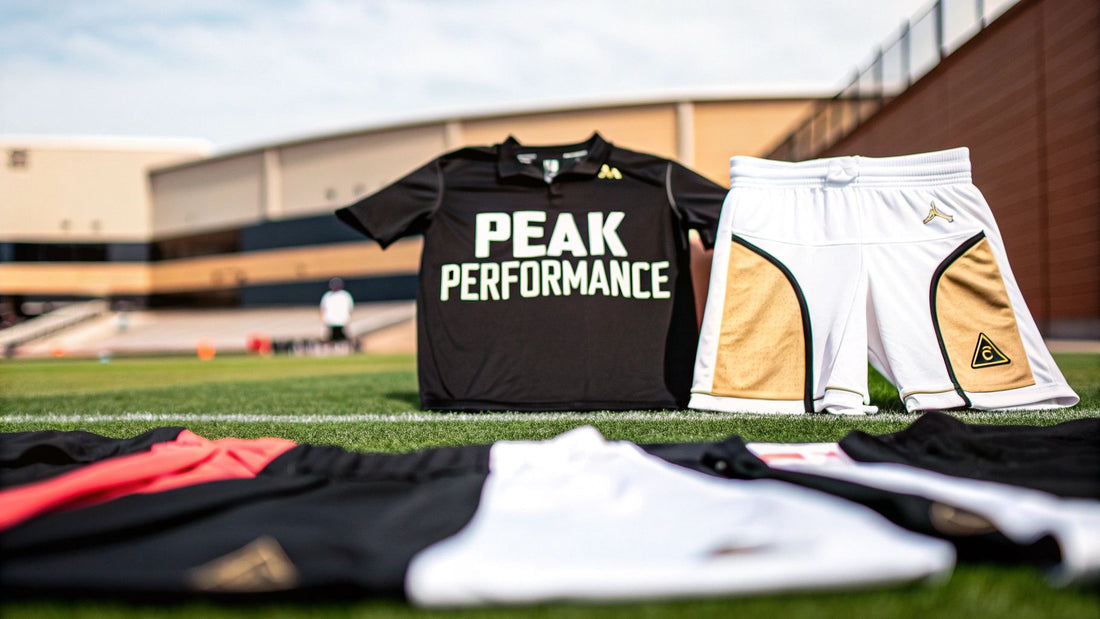Proper football training wear isn't just another set of sportswear; it's a crucial piece of equipment designed for the grind. Think of it as a tool built specifically for the high-intensity, repetitive demands of practice. This gear is your first line of defence against the elements and fatigue, helping you push harder and train smarter every single session.
Why Your Training Kit Is a Performance Tool
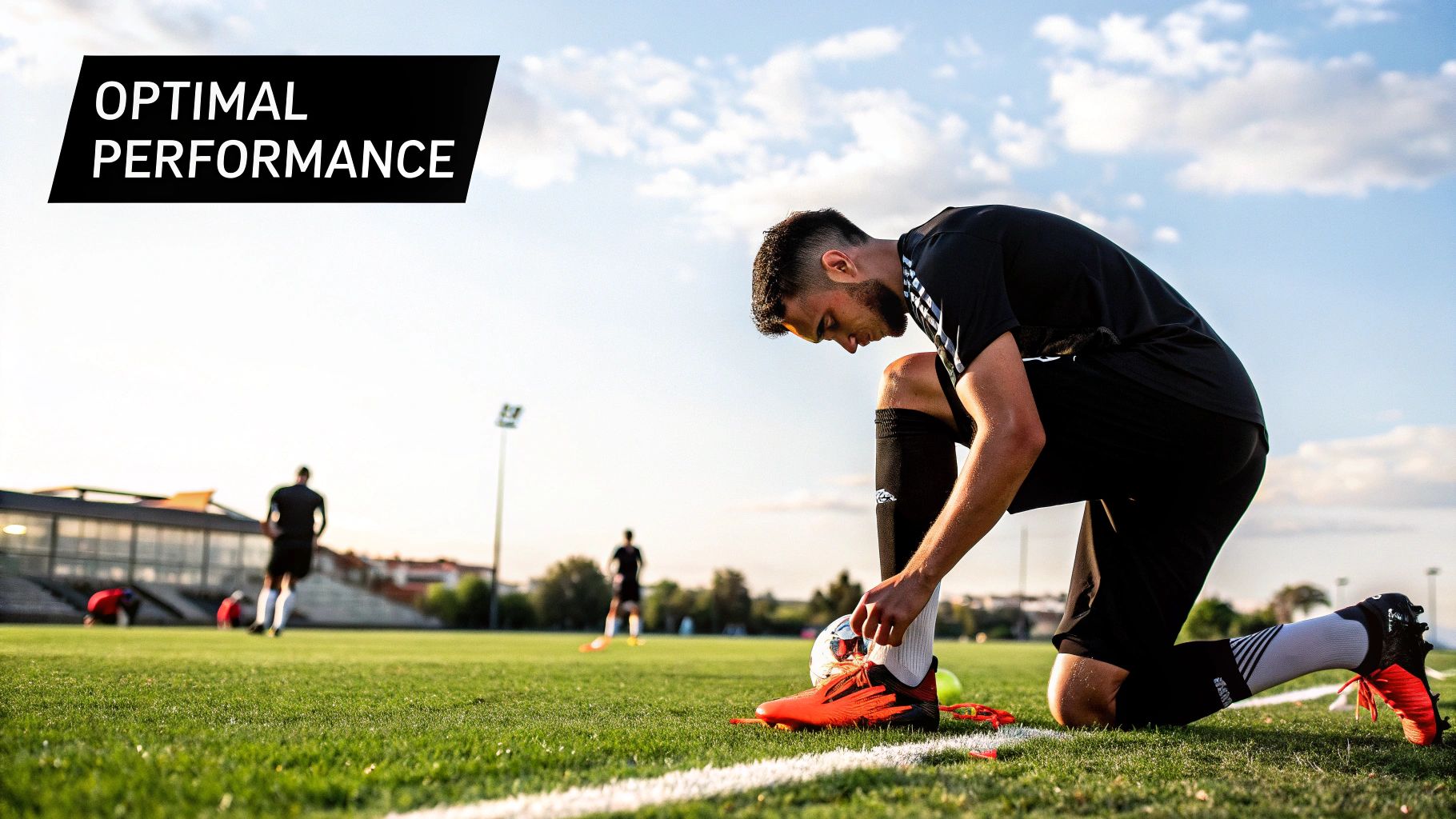
Your training kit is the unsung hero of your performance. While your match-day strip gets all the glory—often lighter and designed for the spotlight—your training gear is the real workhorse. It’s engineered to withstand the daily reality of drills, tackles, and countless washes without falling apart or losing its technical edge.
This difference is key. Training apparel prioritises durability and function over the lighter materials and specific badging of a match shirt. Its job is to create the best possible physical environment so you can focus on pushing your limits in complete comfort.
The Core Functions of Training Apparel
Good football training wear isn't just about looking the part. It serves a few core purposes that directly impact how you perform on the pitch, giving you a real advantage in every session.
The best gear is designed to:
- Regulate Body Temperature: It keeps you warm during those cold morning sessions but helps you stay cool when the intensity ramps up, stopping you from overheating or getting chilled.
- Manage Moisture: Modern fabrics are fantastic at wicking sweat away from your skin. This keeps you dry and comfortable, which means less chafing and better focus.
- Enhance Durability: With reinforced seams and tougher materials, your kit is built to handle the physical demands of frequent, intense practice.
- Optimise Movement: A specialised fit allows for a full range of motion. Your clothing should never get in the way of a sprint, stretch, or tackle.
Investing in proper training apparel is a direct investment in your performance. By managing sweat and regulating temperature, the right gear keeps your mind on the drill, not on your discomfort.
The demand for high-quality gear is no surprise given the sport's massive popularity. In the UK, the football market, which includes football training wear, was valued at a huge $422.23 million in 2024. And with around 45 million people taking part in matches during the 2022-2023 season, the need for reliable, performance-focused apparel is obvious.
This growing market, detailed further on expertmarketresearch.com, has pushed manufacturers to innovate, turning what was once simple sportswear into highly sophisticated performance tools.
What's the Tech in Your Training Kit Actually Doing?
Ever pulled on a training top and wondered what all the fancy tech names actually mean? It’s not just marketing fluff. The science woven into modern football gear is what separates a decent kit from one that genuinely helps you perform better on the pitch. Once you understand it, you can see past the brand logos and pick gear that works for you.
Think of those high-tech moisture-wicking fabrics as a clever one-way street for sweat. When you’re working hard, your body sweats to cool itself down. Old-school materials like cotton just soak it all up, leaving you feeling heavy, damp, and cold. That’s a recipe for chafing and a drop in performance.
Modern performance fabrics do the opposite. They’re designed to pull sweat away from your skin and push it to the outside of the garment. From there, it evaporates in a flash, keeping you dry, light, and focused on the next drill instead of your soggy shirt.
Why the Right Fabric is a Game-Changer
The material you train in has a direct impact on your comfort, stamina, and focus. The right fabric tech works with your body, not against it, managing heat and sweat so you can keep your engine running at its peak for longer.
This is a big deal in the UK, where players at all levels are demanding better, more technical gear. Brands are constantly innovating with breathable fabrics and advanced moisture-wicking materials. There's also a bigger push for sustainable options made from recycled materials. The market is packed with high-performance apparel, and you can see more trends over at precedenceresearch.com.
So when you're browsing for a new training top, remember you're not just buying a piece of clothing—you're choosing a piece of performance equipment.
"The real magic of modern training wear is its ability to create a stable microclimate around your body. By handling sweat and heat efficiently, the right fabric frees up your body to focus its energy on performance, not on trying to cool down or warm up."
Here’s a clear breakdown of the most common materials in your training kit and what they do for you on the pitch.
A Player's Guide to Training Wear Fabrics
| Fabric Technology | Primary Material | Key Benefit | Best For |
|---|---|---|---|
| Moisture-Wicking | Polyester | Pulls sweat away from the skin to the fabric's surface, where it evaporates quickly. | All-weather training, intense drills, and match play. |
| Compression | Elastane/Spandex & Nylon Blends | Provides a snug fit that supports muscles, improves blood flow, and can aid recovery. | Base layers, recovery sessions, and high-impact sprints. |
| Four-Way Stretch | Elastane/Spandex | Allows for complete freedom of movement without the garment losing its shape. | Agile movements, stretching, tackling, and drills requiring a full range of motion. |
| Breathable Mesh | Lightweight Polyester | Features an open-weave construction that allows air to circulate freely, releasing heat. | Ventilation panels in high-heat areas like underarms and the back. |
| Thermal | Fleece-Lined Polyester | Traps a thin layer of warm air against the skin while still wicking away moisture. | Cold-weather training sessions to stay warm without overheating. |
Getting to know these materials helps you read any product label and know exactly how a garment will perform when you need it most.
The Power of Compression and Flex
Beyond just keeping you dry, two other bits of tech define top-tier training wear: compression and flexibility. They might seem like small details, but they make a massive difference in how you move, feel, and recover.
Compression technology is all about those snug-fitting garments. This isn't just a style choice; the gentle pressure helps increase blood flow, getting more oxygen to your hard-working muscles. It also helps reduce muscle vibration during sprints and jumps, which can cut down on fatigue and help you feel fresher post-session. A good pair of compression shorts, for example, gives your quads and hamstrings that extra bit of support, making you feel more stable through every sudden stop and start.
On the flip side, flexibility is all about making sure your kit never holds you back. That's where materials like elastane (you might know it as Spandex) come into play. Blending just a small amount—usually around 5-10%—into a fabric like polyester completely changes the game.
That extra stretch is what lets you lunge for a tackle, stretch out for a header, or twist for a volley without feeling restricted. It ensures your gear moves with you, not against you.
Smart Ventilation for Staying Cool Under Pressure
Finally, always look for gear with smart ventilation. It doesn’t matter how well your top wicks sweat if you’re overheating. That’s why the best training wear has mesh panels built right in.
These panels are like little air-con vents, and they’re usually placed in the areas where you get hottest:
- Under the arms
- Down the sides of your torso
- Across your upper back
This targeted design lets heat pour out and cool air flow in right where you need it most, stopping you from feeling stuffy and overheated during a tough session. Some pieces of kit, like the ones in our guide to football training vests, are almost entirely built around this idea of maximum airflow. Once you understand these core technologies, you can pick your gear like a pro.
Building Your Ultimate Training Wardrobe
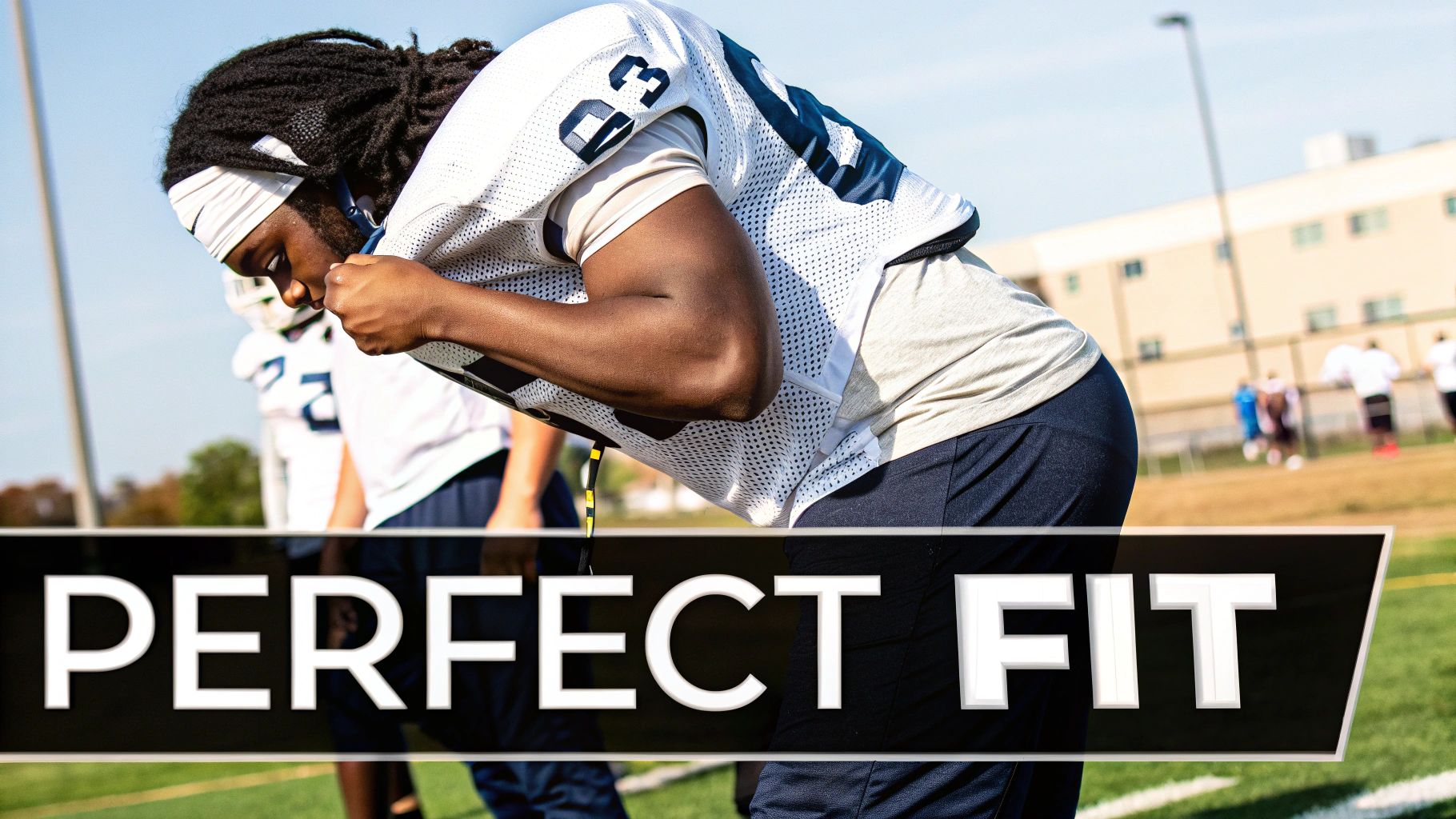
Putting together the perfect training kit isn't about having a mountain of gear; it’s about having the right pieces that all work together. Think of it like a toolbox, where every item has a specific job but can also team up with others to handle any situation you face on the pitch.
With just a few core items, you can easily throw together the perfect football training wear for a freezing winter morning or a surprisingly warm afternoon session. This smart approach saves you money and makes sure every piece you own actually gets used. It’s exactly how the pros stay ready for anything, all season long.
And it’s a big deal. The UK team sports equipment market, which covers all football training wear, is set to bring in US$164.81 million in 2025. That figure just shows how much demand there is for quality gear, from grassroots right up to the elite level. You can dig into more of the numbers over at Statista.com.
The Four Pillars of Your Training Kit
A complete training wardrobe is really built on four essential layers. Each one has a unique role in managing your body temperature and keeping you comfortable, so you can stay focused on the session, not the weather.
These are the non-negotiables:
- Base Layers: This is your second skin. Its main job is to pull sweat away from your body, keeping you dry. A good base layer is key for stopping you from getting chilled in the cold and helping you stay cool when it’s warm.
- Training Tops: The workhorse of your kit. This is the breathable training top or jersey that goes over your base layer (or you wear it on its own). It’s built for maximum airflow and to take a beating.
- Mid-Layers: This is all about insulation. Think quarter-zip tops or lightweight fleeces designed to trap your body heat, keeping you warm without adding bulk or getting in the way of your movement.
- Outer Shells: Your shield against the elements. A windbreaker or rain jacket protects you from wind and downpours, making sure bad weather doesn't cut your session short.
Think of these four pieces as your complete toolkit for performance. Once you learn how to mix and match them, you can create a custom setup for any conditions, giving you total control over your comfort and focus.
Essential Items and What to Look For
Right, let's break down the specific items that make up a great training wardrobe. When you're picking these out, it’s the small details that often make the biggest difference on the pitch.
Training Tops and Shorts
These are your everyday essentials. You want lightweight, moisture-wicking fabrics that feel soft and don’t chafe. For tops, look for ones with mesh panels under the arms for a bit of extra ventilation. With shorts, an elasticated waistband with a drawstring is a must for a secure fit. Some players also swear by pairs with zipped pockets to keep keys or a phone safe.
Training Trousers and Bottoms
Absolutely crucial for colder days. Modern training trousers are tapered for a slim fit that doesn’t flap around your ankles or get tangled up when you're on the ball. Ankle zips are a game-changer here—they make it so much easier to get your trousers on and off over your boots.
Quarter-Zip Tops
This is probably the most versatile piece any player can own. A quarter-zip is the perfect mid-layer. You can zip it right up to trap heat during your warm-up, then pull it down for instant ventilation when the session gets intense. Little features like thumbholes in the cuffs are great for extra coverage and stop the sleeves from riding up.
By understanding what each piece does and the key features to look for, you can start building a training wardrobe that’s cohesive and genuinely effective. To see how all these items come together, check out our guide on how to assemble the perfect football training kit.
How to Master Layering for Any Weather
Anyone who plays football in the UK knows the weather is the one opponent you can never predict. One minute you're starting a session in the biting cold, the next the sun breaks through and you’re sweating buckets. Mastering your layers isn't just about comfort—it's a genuine skill that helps you maintain peak performance, whatever the sky throws at you.
Think of it like insulating a house. You don’t rely on one massive, thick wall. Instead, you use several layers that work together to trap heat and keep the elements out. Your training gear should work the exact same way, using a simple but incredibly effective three-layer system to keep your body at the perfect temperature.
This smart approach means you can adapt on the fly. Getting too warm after the first few drills? Just peel a layer off. A sudden downpour? Throw your outer shell back on. The whole point is to use lightweight, packable items that are easy to add or shed without breaking your stride.
The Three-Layer System Explained
The secret to all-weather comfort is the three-layer system. Each piece has a specific job, and when they work together, they keep you dry, warm, and protected from the wind and rain. Get this right, and you'll stay focused from the first whistle to the last.
-
The Base Layer: This is your second skin. Its one and only job is to pull sweat away from your body. A good base layer, like a compression top, wicks moisture to the outer surface where it can evaporate. This stops you from getting that horrible cold and clammy feeling when you stop moving.
-
The Mid-Layer: This is your insulation. Think of a quarter-zip top or a lightweight fleece. It traps a thin layer of air warmed by your own body heat, keeping you warm without adding loads of bulk that could get in the way of your movement.
-
The Outer Layer: This is your shield against the elements. A windbreaker or a lightweight rain jacket is essential for blocking out wind and showers—the two biggest culprits for stealing warmth and draining your energy on a miserable day.
This image shows what features players are really looking for in their gear. A huge 65% prioritise ventilation, 50% want a compression fit, and 40% still opt for bold prints to stand out.
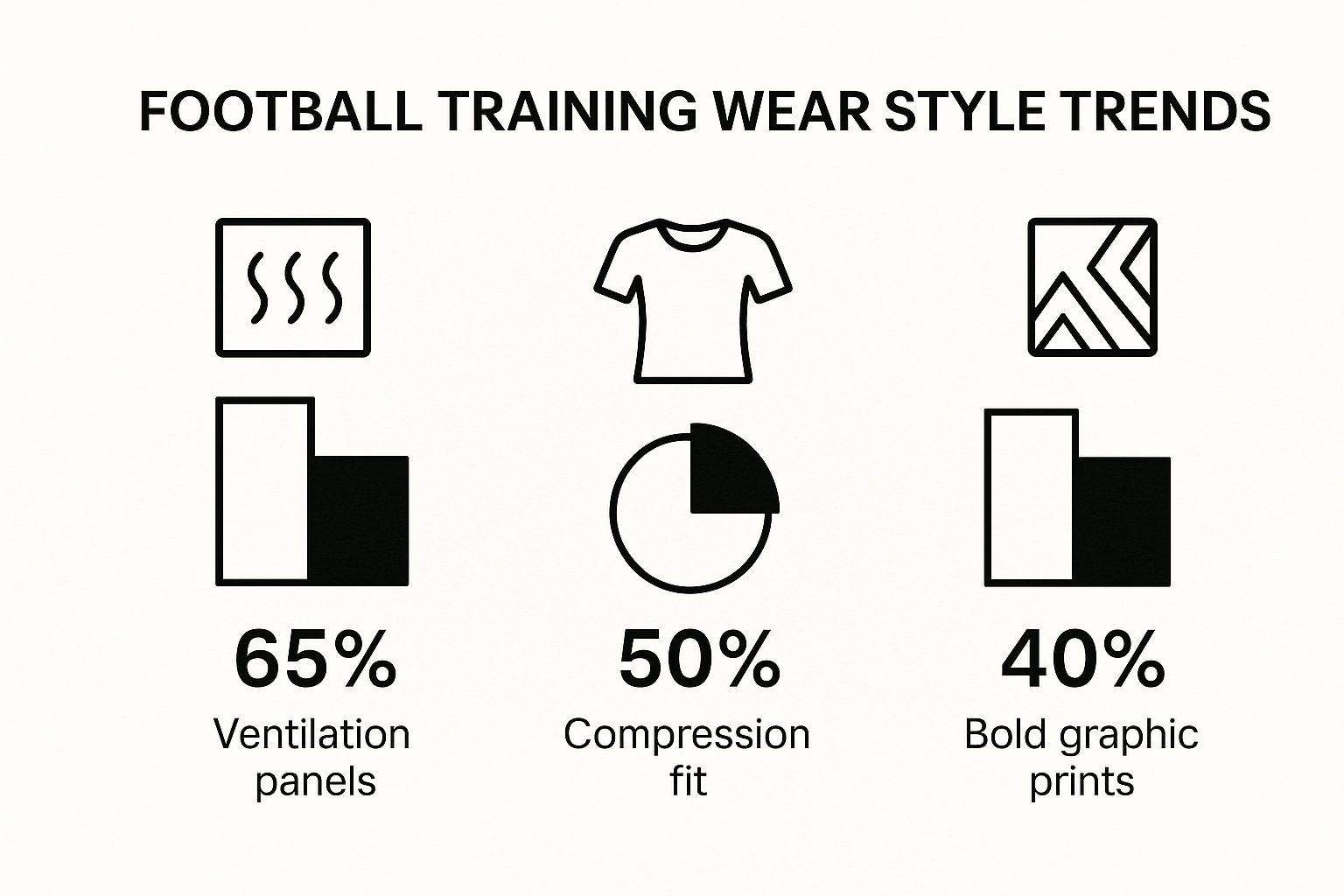
It’s clear that functional design is king. Performance features like ventilation panels and compression fits aren't just buzzwords; they're what most players demand from their kit.
Your Layering Game Plan for All Conditions
Knowing the theory is one thing, but putting it into practice on a wet Tuesday night is what really counts. You need to be able to build the right combination of layers for the specific conditions you're facing.
Here's a quick-reference table to help you build the perfect kit for any training scenario.
| Weather Condition | Base Layer | Mid-Layer | Outer Layer |
|---|---|---|---|
| Cold & Dry | Long-sleeve compression top | Quarter-zip or fleece | Not needed (unless windy) |
| Mild & Damp | Short-sleeve wicking tee | Optional (keep one handy) | Lightweight windbreaker |
| Cold & Wet | Long-sleeve compression top | Lightweight fleece | Water-resistant rain jacket |
| Very Cold & Windy | Thermal base layer | Insulated mid-layer | Windproof outer shell |
The goal is to have an adaptable system. The perfect setup is one you can adjust in seconds, ensuring your clothing never becomes a distraction from the real focus: the football.
Why the Right Fit Is a Game Changer
Choosing the right size in your football training wear is about more than just reading the label. Think of it this way: the perfect fit is a genuine performance tool. It directly impacts how you move, how comfortable you feel, and ultimately, how well you can actually train.
It’s the difference between gear that feels like a part of you and gear that actively gets in your way.
A badly fitting kit is a massive distraction. If it’s too loose, it’ll bunch up, snag on things, and cause painful chafing as the spare fabric rubs against your skin. On the flip side, gear that’s way too tight is just as bad. It can restrict your blood flow and seriously limit your range of motion right when you need to open up your stride or twist for a pass.
Finding Your Ideal Performance Fit
Getting your head around the main types of fit will help you pick gear that actually matches what you're doing on the training ground. Each style is designed with a specific job in mind, giving you a different kind of edge.
There are three main fits you’ll come across:
- Compression Fit: This is your classic ‘second skin’ fit. It’s tight and designed to offer targeted muscle support. The idea is to improve blood circulation and cut down on muscle vibrations during explosive movements, which can even help with recovery.
- Slim Fit: This is that modern, body-hugging cut that sits close without feeling restrictive. It gets rid of any excess fabric, which reduces drag and stops your kit from flapping about—perfect for fast-paced, agile drills where every split-second counts.
- Regular Fit: This is the traditional, more relaxed fit that’s all about comfort and freedom. It gives you plenty of room to move and allows for great airflow, making it a solid choice for general training sessions, warm-ups, or cool-downs.
The goal is simple: find a fit that feels like an extension of your own body—something you completely forget you’re even wearing. That’s when you can put all your focus on your technique and performance, not on your kit.
The Practical Try-On Test
When you’re trying on new training wear, don't just stand there and look in the mirror. You’ve got to put it through its paces. A few simple movements that copy what you’ll actually be doing on the pitch is the only real way to know if it’s right.
Before you commit to a new bit of kit from our collections at soccerwares.com, run through this quick checklist. It’ll tell you everything you need to know.
- Perform a Deep Squat: Do your shorts or trousers feel like they’re pulling tight around your hips and thighs? You need a full range of motion without any restriction.
- Raise Your Arms Overhead: Does your top ride up and expose your stomach? A good fit should stay put, no matter how much you stretch.
- Twist Your Torso: Mimic turning to shield the ball or receive a pass. The fabric should move with you, not fight against you. You shouldn’t feel it pulling across your shoulders or back.
- Do a High Knee Run: Make sure your shorts or trousers don’t hold you back. The material needs to be flexible enough for those explosive leg movements.
Taking a minute to do these simple tests makes sure your gear will have your back through every sprint, tackle, and drill, letting you play without anything holding you back.
Keeping Your Gear in Premier League Condition
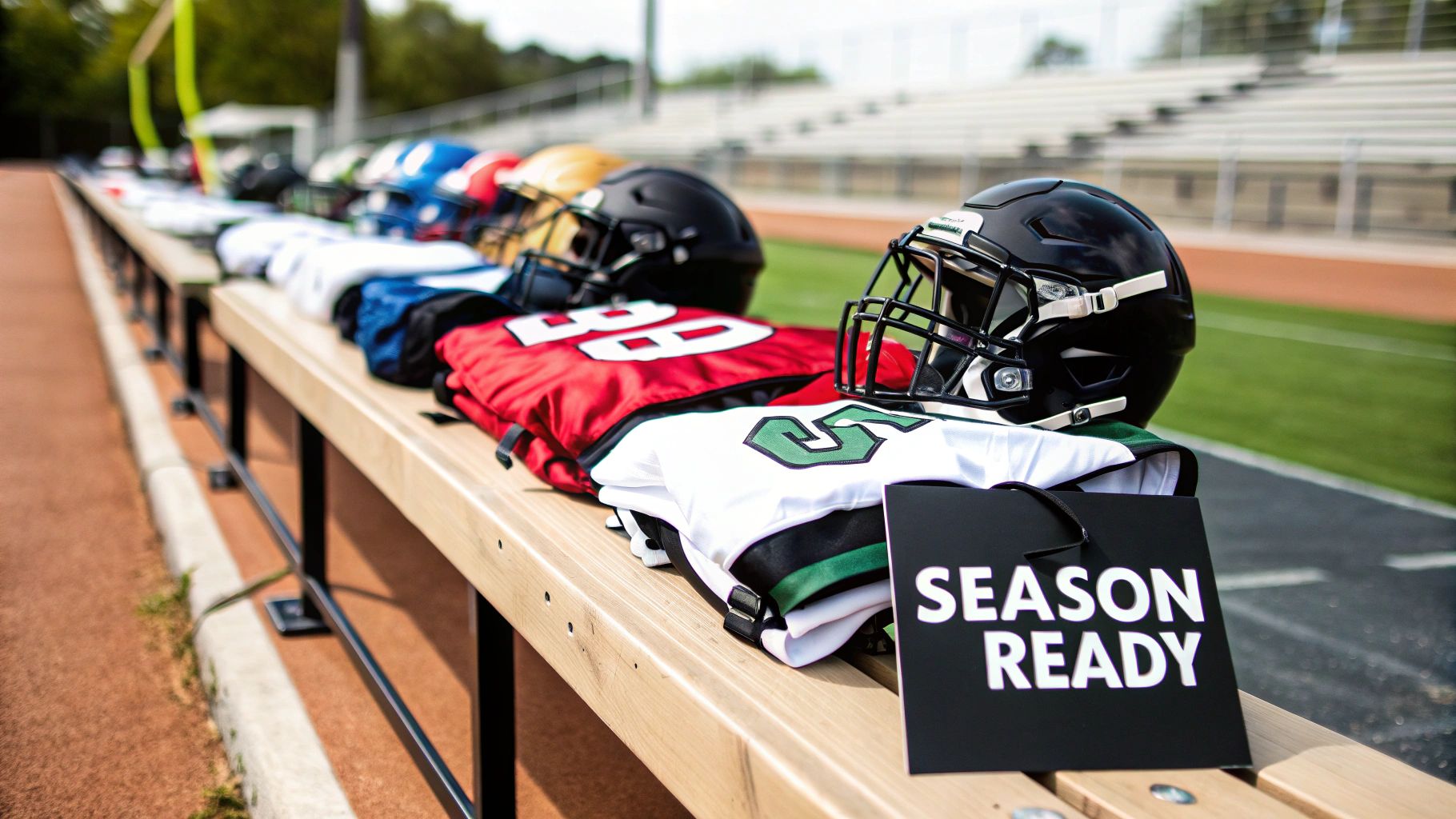
Your high-tech football training wear is a serious investment in your performance. But let’s be honest, after a tough, muddy session, it’s tempting to just chuck it all in a hot wash and hope for the best.
That’s the quickest way to destroy the very fabric technology you paid good money for. Proper care isn't just about keeping it clean; it's about making sure your gear performs as hard as you do, every single time you step on the pitch.
Following a few simple rules will make your kit last season after season, keeping its technical features fully intact. Think of it as protecting the science woven into every fibre.
The Science of Washing Your Kit
Ever wondered why the care label is so specific? It’s not just a suggestion. High heat from a tumble dryer, for instance, is the arch-nemesis of elastane—the stuff that gives your base layers their supportive stretch. Heat literally breaks down those fibres, leaving them saggy and useless.
And fabric softener? It might make your towels feel amazing, but on performance wear, it's a total disaster. It leaves behind a waxy film that clogs up the microscopic pores in moisture-wicking fabrics. This basically suffocates the material, killing its ability to pull sweat away from your skin.
Think of your training wear's fabric like a high-performance engine. You wouldn't put the wrong fuel in it. Fabric softener and high heat are the wrong fuel for technical apparel, ruining its ability to perform.
By treating your gear correctly, you're not just washing it; you're maintaining a crucial piece of your football training equipment.
Your Essential Care Checklist
Keeping your gear in top condition doesn't require a complicated routine. You just need to stick to a few non-negotiable rules to protect the fabric's integrity and get the most out of your investment.
This quick checklist will keep your kit performing at its best.
The Golden Rules of Gear Care:
- Do Wash Promptly: Don't let sweaty gear fester in your kit bag. That’s a breeding ground for bacteria that causes those stubborn odours that never seem to wash out. Get it in the machine as soon as you can.
- Don't Use High Heat: This is the big one. Always wash your kit in cold water (at 30°C) and never put it in a tumble dryer. High temperatures will wreck technical fibres, melt logos, and shrink your gear.
- Do Turn It Inside Out: A simple trick to protect prints, badges, and logos from getting battered around in the wash cycle. It keeps them looking sharp for longer.
- Don't Use Fabric Softener: We’ve said it once, but it’s worth repeating. It blocks the fabric's pores and ruins its moisture-wicking capabilities for good. If you can, use a specialised sports detergent instead.
- Do Air-Dry Naturally: Hang your kit on a line or a drying rack away from direct, harsh sunlight. You'll be surprised how quickly modern fabrics dry on their own, and you'll completely avoid heat damage.
- Don't Use Bleach: Harsh chemicals like bleach will weaken the fabric fibres and can cause weird discolouration. Just don't do it.
Got Questions About Football Gear? We’ve Got Answers
Even when you know the basics of fabrics and layering, there are always a few lingering questions that pop up. It’s completely normal. Choosing the right football training wear can feel like a minefield of technical jargon.
Think of this section as your quick-fire guide to clearing up those last few doubts. We’ll tackle the most common questions we hear, helping you spend your money wisely and pick gear that actually backs you up on the pitch.
Training Tops vs. Match Shirts
So, what’s the real difference between a training top and a proper match shirt?
It all comes down to durability and focus. Training tops are the workhorses of your kit bag. They’re built from tougher, more robust fabrics designed to survive the daily grind of muddy pitches, constant washing, and being tugged about in drills. Function comes first, which is why you’ll often find reinforced seams and hard-wearing material blends.
Match shirts, on the other hand, are your Sunday best. They’re often lighter and designed with aesthetics in mind for supporters and TV broadcasts. They have to feature official club crests and sponsor logos in a very specific, regulated way. Their job is peak performance for 90 minutes, not to endure relentless training week after week.
A training top is a tool, built for repetition and resilience. A match shirt is a uniform, designed for performance on a single day.
Can I Just Use My Running Gear for Football?
It's tempting to throw on your running top for a kickabout, but is it a good idea?
In a pinch, it’s better than wearing a cotton t-shirt, but it’s far from ideal. Running gear is engineered for one thing: linear, forward motion. It’s lightweight and breathable, sure, but it completely lacks the durability needed for the chaos of a football match.
Football training wear is built for explosive, 360-degree movement—we’re talking sudden cuts, sliding tackles, shielding the ball, and getting pulled back by a defender. The materials are stronger and the seams are reinforced to handle the unique physical stress of the game. That running top just won’t last.
When Should I Replace My Training Wear?
How do you know when it’s time to retire your favourite training top?
Forget looking for obvious holes or tears. The first thing to go is the technical performance, long before the gear looks completely worn out. It stops doing its job properly.
Here are the key signs your kit is past its prime:
- It’s Lost Its Shape: If the waistband on your shorts is baggy or the compression zones feel loose, the elasticity is gone.
- It Stays Damp: Remember how it used to dry quickly? If it now feels heavy with sweat and stays wet, the moisture-wicking properties have faded.
- That Lingering Smell: When a funky odour sticks around even after a thorough wash, it means bacteria have permanently settled in the fibres and are breaking them down.
- The Fabric is Thinning: Hold it up to the light. If you can see through it in high-wear areas like the knees or shoulders, its structural integrity is shot.
At SoccerWares, we believe the right gear lets you focus on one thing: playing your best. From training tops that can take a beating to bottoms built for performance, our collection is designed to meet the demands of every single session.
Ready to upgrade? Explore our full range of training essentials and find the kit that will elevate your game.

